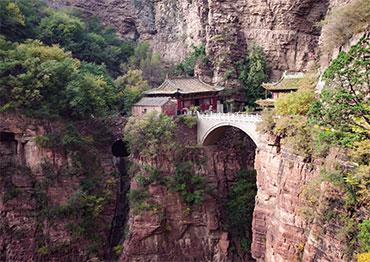Perhaps the most well-known of these is Zhengding County, which has been an important center for Buddhism for centuries. The most famous attraction of the county, which is a short 15 kilometers away from the city center, is Longxing Temple, which is apparently known as “the best temple south of Beijing.”
It’s not clear to me whether or not that phrase means “anywhere south of Beijing” or “immediately south of Beijing” – it is a rather excellent temple, so either is arguable. Its founding dates back to the 6th century, but while it does have a stele from that time, what’s still standing dates to the later Song Dynasty (960-1279), with a few licks of paint since. Indeed, it’s considered to be a particularly outstanding example of Song architecture, especially the complex wooden roof of its main hall, which is supported by dozens of interlocking wooden eaves.
Also of particular note is a genuinely aweinspiring 20-meter bronze statue housed in one of the halls, depicting a multi-armed Guanyin, originally cast over 1,000 years ago, though much restored since. Sadly, they don’t allow visitors to climb the staircase along the inside of the hall to get a better look at its face. It’s also home to a rare, early and particularly large example of a revolving wooden library which once housed sutras.
But that’s not all the history Zhengding has to offer. Within a walkable distance from Longxing Temple are four neighboring pagodas, looming large over the low-slung old town. Each is ancient and impressive, but they’re also very distinct from one another. While the most impressive is doubtless the 48-meter tall Xumi Pagoda, my personal favorite is the charming Hua Pagoda, covered with sculptures of elephants and aquatic animals. Each requires a small entrance fee to get a close look, but you can easily just peek over the wall if you’re desperate not to part with your cash.
The area around the pagodas is classic commercial old town fare, with countless chances to get stuff on a stick. Shijiazhuang doesn’t really have many signature foods, but while you’re in Hebei you might want to grab one of the province’s most iconic snacks – the donkey burger. Chopped donkey meat is presented in a flaky pocket, sometimes with the addition of peppers if the place wants to treat you. While munching on Eeyore may put some off, its actual deliciousness is attested to by the Hebei saying, “in heaven there is dragon meat, on Earth there is donkey meat.”
To the west of the city is Mount Cangyan, the eastern peak of the Taihang mountain range which straddles the border between Hebei and Shanxi. Nestled on the mountain is Fuqing Temple, which had its distinctive mountainside bridge immortalized at the elegiac ending of the Ang Lee-helmed movie Crouching Tiger, Hidden Dragon. While there is a cable car up, that’s best left for the trip down, as its an easy enough walk to the top, and you’ll have more time to enjoy beautiful mountain views.
Another little piece of history tucked away in the city’s southern rural areas is Anji Bridge. Also known as Zhaozhou Bridge. Also known by the rather unsubtle name Dashi Bridge, or “big stone bridge.” This 50-meter-long elegant stone bridge was built over 10 years ending in 605, making it the oldest in-use bridge in China and the oldest stone bridge of its type (for the nerds, that’s “open spandrel”) in the world. While trekking your way for an hour out of the city to walk across a bridge may seem strange to some, the simple idea that it has been there for so long – and still looks so great – can make this a memorable experience that really brings home the historic achievements of Chinese engineering.
Fittingly for a city that owes its existence to the railway, the city is well-connected with both conventional and (your more likely choice) high-speed trains. A direct train will get you from Beijing West Station to Shijiazhuang’s cavernous railway station in little more than an hour.
Before you dash off after your arrival, go stand in one of its two squares and enjoy the feeling of a tidal wave of concrete looming over you from the station’s jutting roof. While Zhengding is easily reachable by public transportation in about an hour – you can take the recently opened subway about halfway there and then get a public bus – Anji Bridge and Mount Cangyan are less convenient. Your best bet is to rent a car.
Naturally, as a major city, Shijiazhuang has plenty of hotels. One upside of its somewhat lagging tourism sector – and perhaps reluctance for business travel during the unpredictable pandemic – is that even big-name international hotels are relatively affordable. As of the time of writing, a night’s stay in the upmarket Intercontinental Shijiazhuang is going for less than half the price of its sister hotels in Beijing or Shanghai.

 Old Version
Old Version


